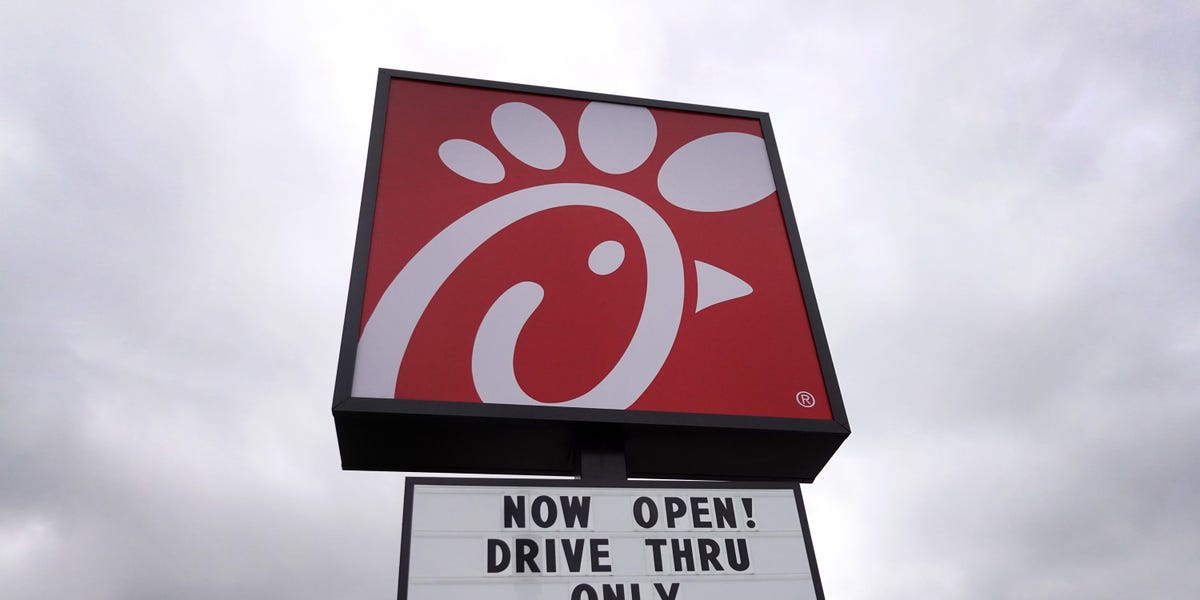- Chick-fil-A‘s fee for a new restaurant is $10,000 – one of the lowest of any major fast-food brand.
- Chick-fil-A restaurants average about $8.7 million in sales annually among non-mall locations.
- Despite the potential success and low startup costs, restrictions placed on franchisees might not be worth it.
Chick-fil-A is among the most successful fast-food chains in the US with one of the lowest franchise fees of any major fast-food brand.
In 2022, the chain booked sales of $18.8 billion, up 12.8% from the year before,according to Nation’s Restaurant News Top 500 report. Chick-fil-A restaurants generate higher revenue per location than any other national chain. In 2022, most locations average nearly $8.7 million in sales per year, up from $8.1 million a year ago, according to the chain’s 2023 Franchise Disclosure Document. Mall locations average sales of $3.7 million.
“That’s more than double a McDonald’s, and McDonald’s is no slouch,” veteran restaurant analyst Mark Kalinowski said of Chick-fil-A’s non-mall restaurants.
By comparison, McDonald’s restaurants posted average domestic sales of $3.7 million in 2022, according to the chain’s franchise disclosure report for 2023.
Despite its success, Chick-fil-A charges a franchise fee of $10,000 to open a new restaurant, and the company told Business Insider it doesn’t require candidates to meet a threshold for net worth or liquid assets.
Those fees are cheaper than most other major fast-food chains in the US, including McDonald’s, whose operators view Chick-fil-A as its biggest rival.
McDonald’s, for example, requires potential franchisees to pay from $1.5 million and $2.5 million in startup costs — including a $45,000 franchise fee, according to the chain’s 2023 FDD.
Potential Taco Bell franchisees pay the same $45,000 fee with startup costs ranging between $1.4 million to $2.5 million for a traditional restaurant, according to the chain’s 2022 FDD.
Total costs to launch a franchised Chick-fil-A restaurant ranges from $518,385 to $2,803,435, according to the 2023 FDD documents. In 2022, Chick-fil-A reported a range of $219,055 to $2,912,697, according to 2022 FDD documents.
Chick-fil-A, however, makes up for the loss of upfront capital investment with other costs to franchisees, such as real estate, restaurant construction, and equipment, which it leases to the franchisee.
“The challenge to becoming a franchisee is never going to be money,” a Chick fil-A spokesperson told Insider. “We seek to find business-minded restaurant operators who find great joy in making other people’s days”
So what’s the catch?
While Chick-fil-A’s franchise fee is low, the ongoing fees are higher than those charged by many of its rivals, and they start adding up on day 1.
McDonald’s charges an ongoing monthly service fee equal to 4% of gross sales, while Chick-fil-A franchisees pay a “Base Operating Service Fee” of 15% of sales, and an additional fee of 50% of net profits.
Both McDonalds and Chick-fil-A charge rent, with golden arches owners paying an average of 10.7% of sales in rent costs, while Chick-fil-A limits its rent charges to 6% of sales.
While a Chick-fil-A costs less up-front, over time franchisees end up paying a lot more to the company to operate the business. And that’s not all.
Beyond the unusual fee structure, there are several other items that might give a prospective franchisee pause.
For starters, Chick-fil-A prohibits most of its franchisees from opening multiple units, which can limit potential profits, and franchisees must devote their full time and attention to operating the actual business.
A Chick-fil-A spokesperson told Insider it selects “a relatively small number of franchisees to operate multiple units.”
Franchisees are also prohibited from owning or working in any other fast food business within five miles of their Chick-fil-A location.
The company says this limitation is meant to enable franchisees to be intimately involved in the day-to-day operations of their restaurants, and it encourages franchisees to be actively involved in the communities where they live and work.
“Chick-fil-A operators must be as comfortable rolling up their sleeves in the kitchen as they are shaking hands in the dining room,” the spokesperson said.
Another issue that may be of concern regards franchisees’ actual control over their business.
Franchisees are business owners by definition, but Chick-fil-A’s FDD prevents franchisees from exercising a key benefit of ownership: selling the business.
No transfer or sale of a Chick-fil-A business is allowed, not even family inheritance in the event of death or disability.
Chick-fil-A also reserves the right to terminate any franchisee’s agreement without cause with 30-days notice, or with cause for infractions such as subjecting the brand to “scandal,” filing for bankruptcy, opening your restaurant on a Sunday or Christmas Day, or if your operations are “frustrated” by labor union activity.
The application process
Chick-fil-A’s model may be unusual, but it’s incredibly popular and competitive. However, it’s very selective and more than 40,000 candidates a year apply to become a franchisee.
To apply, candidates have to submit a form through the company’s website expressing their interest, and from those candidates, Chick-fil-A selects between 75 to 80 new franchisees annually.
Applicants do not need previous Chick-fil-A experience.
“More than 40% of our newly selected franchised operators never worked for Chick-fil-A Inc. or at a Chick-fil-A restaurant before applying to become a franchised operator,” according to the company’s website.
In addition to interviewing the candidates themselves, the company may also interview candidates’ friends, family members, and business partners.
Once they are selected and hired, franchisees have to undergo a multi-week program that includes about 160 hours of classroom training before they can open and operate their own restaurant.
Read the full article here





